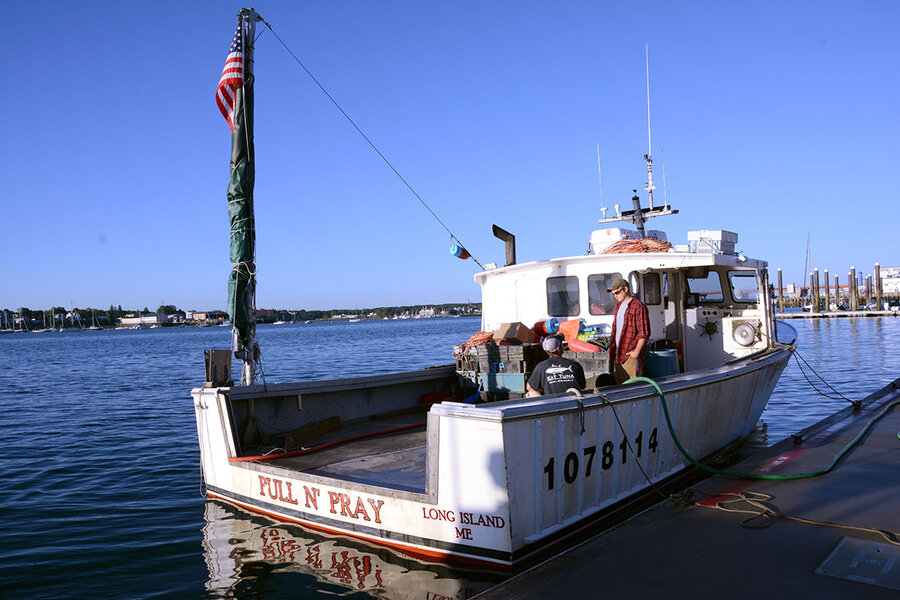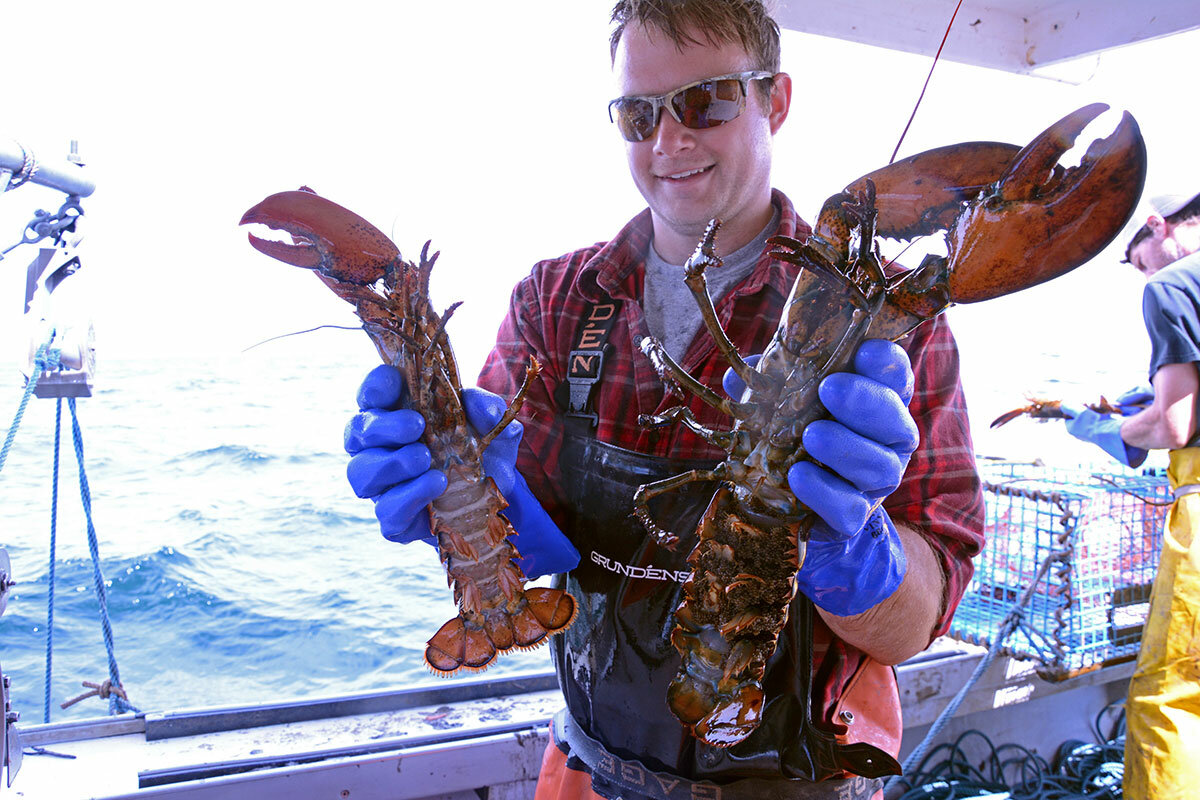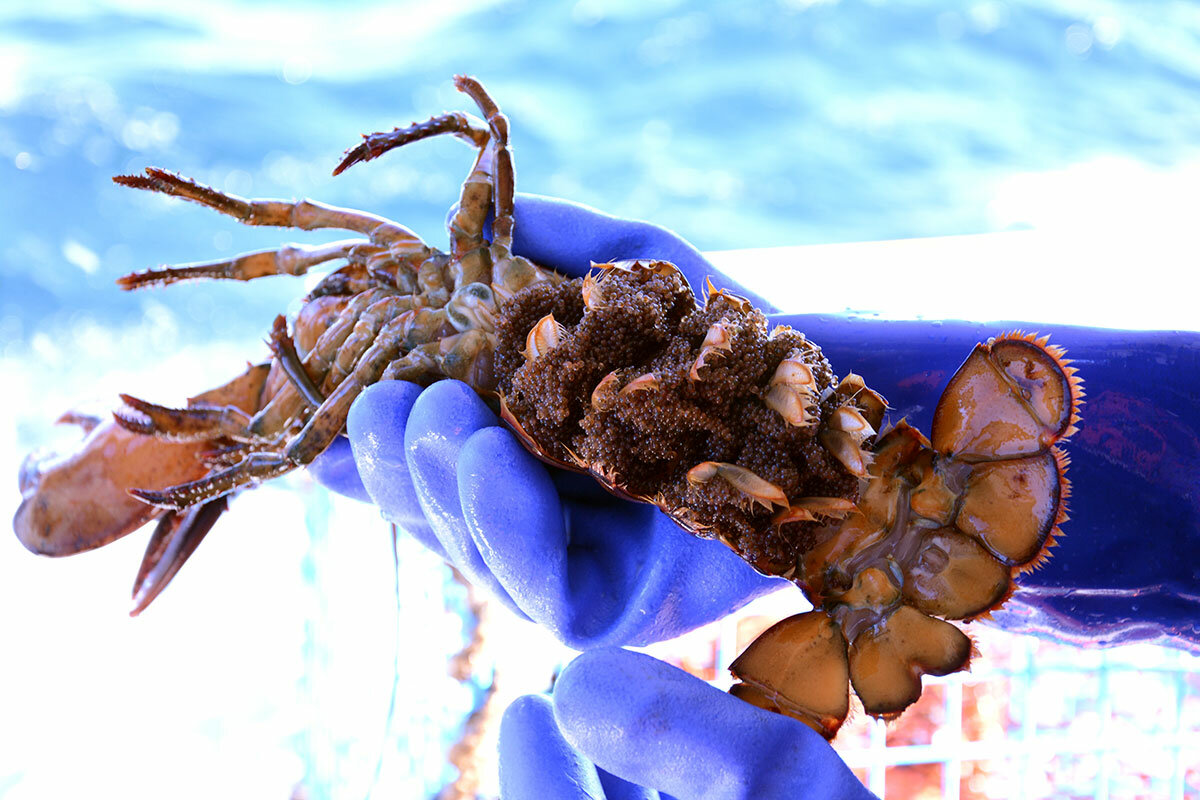For Maine lobstermen, conservation and success go hand in hand
Loading...
| Gulf of Maine
It’s 7 a.m. on the Pull n’ Pray. The lobster boat rocks over large swells as the water sparkles in the June morning sun. The grating whirr of the hydraulic winch drowns out the hum of the boat’s motor as it lifts the first lobster trap of the day out of the water. Justin Papkee swings the trap up onto the side of his boat and quickly opens the latch. Suddenly there are lobsters flying through the air.
Mr. Papkee’s blue rubber gloved hand is nearly a blur as he reaches again and again into the open trap, tossing the lobsters back into the water rapid-fire before pulling in the next trap.
Splash. Splash. Splash.
Why We Wrote This
Conservation efforts are often portrayed as being in opposition to economic interests. But to most Maine lobstermen environmental sustainability is an economic imperative – and a source of pride.
Occasionally he pauses to measure a lobster, or check for a notch or dense clusters of eggs on its tail. After Papkee and his sternman, Jim Ranaghan, have hauled up and sorted through all 16 traps on this line, just one keeper sits in a milk crate on the deck. Then, it’s onto the next set of traps.
This is a worse than average day for the lobsterman, but even on the absolute best days Papkee throws back about half of the lobsters he catches. On those days, he says, it feels like he’s keeping them all by comparison.
Papkee had traveled about 10 miles offshore from Portland to check his traps. It took more than an hour to get to the first of his red and blue buoys. But as he tosses lobster after lobster back into the ocean, Papkee seems unfazed.
“This is just how it’s done,” he says.
Maine has particularly strict rules about which lobsters can be kept. But lobstermen generally don’t resent those laws. In fact, they’re the ones that came up with most of them.
The conservation of natural resources is often portrayed as being in opposition to economic interests, placing the good of the globe over individual livelihoods. But most Maine lobstermen don’t see it that way. They have what has been called a “conservation ethic” that dates back more than a century and has yielded a long list of sustainability rules.
“When you think about this at first glance, it seems crazy. They caught them, why would they want to throw them back?” says Matt Jacobson, executive director of the Maine Lobster Marketing Collaborative. “[The lobstermen] are very mindful of the notion that they are the protectors of the resource.”
This has made Maine lobster one of the world’s most sustainable fisheries. In 2016, the region earned certification from the international Marine Stewardship Council for its “rigorous sustainability requirements,” which have also contributed to a boom the industry is currently experiencing. And with climate change presenting a new challenge for Maine’s iconic lobsters, some researchers say, this commitment to conservation may be more important than ever before.
Nurturing a ‘conservation ethic’
The duty to protect the resource was ingrained in lobsterman Sonny Beal at just five years old. His father taught him to prioritize the health of the fishery over the weight of his hauls, just like generations before him. He learned to measure lobsters, to check if they were reproductive females, and to notch the tails of any egg-bearing females before throwing them back. Now a lobsterman and father himself, Mr. Beal is teaching his two sons the same.
“I think that we’ve got something really great here and will have something really great for a long time to come because we do take care of it every day,” Beal says. Lobstermen have been passing the tradition of conservation down through generations of sons (and more recently daughters as well) for decades.
“It’s not just our fishery. It’s going to be passed on to future generations. Everyone’s so interconnected in this industry. We all kind of need each other,” says Krista Tripp, who also began lobstering with her father as a child. “These measures are so important.”
It all started in the late 1800s. Well before conservation and sustainability became the domain of environmentalists, Maine lobstermen began taking steps to ensure that there would be lobsters in the future for themselves and their children and grandchildren. Eventually some of these measures became law, like the 1872 law banning the harvest of egg-bearing female lobsters and the 1874 law that established a minimum legal size to harvest lobsters.
But not all lobstermen embraced these conservation measures right away. In the early 1900s some lobstermen ignored the sustainability laws and scrubbed eggs off of lobsters to sell them or kept lobsters that were legally too small to harvest to feed themselves, says James Acheson, a retired anthropologist who spent much of his career studying the Maine lobster industry.
Then, lobster populations plummeted. In the late 1920s and early 1930s, lobster catches dropped to less than half the amount seen just a decade earlier. This was compounded by the economic woes of the Great Depression and close to half of Maine lobstermen went out of business. Those who remained struggled.
At the height of this crisis, some Maine lobstermen wanted to harvest as many lobsters as possible while they still could. But others were willing to try anything to save the future of the industry. The second group won out, and a new sustainability law passed in 1933. The so-called double-gauge law added a maximum size limit to the existing minimum. The idea was to protect the larger female lobsters that produce many more eggs than smaller ones, and the larger males that they prefer to mate with.
In the following years, lobster landings rose. It’s unclear if it was the double-gauge law that did it, Dr. Acheson says, but lobstermen were sold. As a result, the culture began to shift. Lobstermen increasingly supported conservation measures, came up with new ones, and even began to report violations of others to the commissioner and wardens.
But “that conservation ethic isn’t rooted in virtue,” Acheson says. “You have the ethic because it seems to work.”
The double-gauge law persists today. Lobsters with a carapace (body shell) length under 3.25 inches or over 5 inches are illegal to harvest in Maine.
Once this conservation ethic had taken off among Maine lobstermen, lobstermen began taking it upon themselves to expand sustainability practices.
That was the case with the V-notch method, which drew inspiration from a state program that began in 1917. Wardens bought egg-bearing lobsters they found in lobster pounds, marked their tails with a notch, and then tossed them back into the sea. The notch indicated to lobstermen that this was a reproductive female and therefore illegal to harvest. Lobstermen began taking up the practice and cutting a V-notch in the tails of egg-bearing lobsters. The practice caught on and in time became the norm.
Today, lobstermen in Maine are legally required to cut a V-notch into the tail of any egg-bearing lobsters they catch, although it’s a difficult law to enforce without a warden on every boat. Still, many of the reproductive-size female lobsters in Papkee’s traps have a notch, or the remnant of one fading through a few molts. In those cases, he deepens the notch to continue to protect the proven breeder.
“We’re not looking to next year,” Papkee explains while gently returning an egg-bearing lobster that he just notched back in the water. “We’re looking a decade from now.” Lobsters take around seven years, perhaps even more, to reach legal size.
A point of pride
Conservation is a cornerstone of the Maine lobster industry today, and that’s something that lobstermen take great pride in.
“Everybody knows that that’s why the lobster population is the way it is now,” Beal says of the sustainability measures. “People realize that it has helped the industry tremendously since they started applying it … and understand that this is what we need to do to keep this thing going.”
And the fact that lobstermen themselves came up with these sustainability measures rather than having rules imposed upon them is a particular point of pride for Papkee and others. “Sustainability measures are a good thing when fishermen come up with them,” he says. Lobstermen’s hands-on knowledge of lobsters and the ocean is integral, he says.
Conservation measures in Maine go beyond outlining which lobsters can and cannot be harvested. Lobsters can only be harvested using traps, those traps are designed to trap as few illegal lobsters as possible, and zoning laws, trap limits and other licensing and management laws are also designed to help maintain a stable lobster population in the Gulf of Maine.
Most other fisheries have a minimum size law to allow the animals to reproduce before being caught, but that’s not enough, says Robert Steneck, a marine ecologist at the University of Maine. “It’s kind of like, ‘let’s preserve the babies.’ But the obvious problem there is that if you’re really efficient at getting all the mommies, then it sort of renders that management tool moot.” The many laws in Maine aim to protect lobsters at other stages of life, too.
Boom, bust, and resilience
Today, the Maine lobster industry is experiencing an unprecedented boom. Every year starting in 2011, lobstermen have hauled in over 100 million pounds of American lobster, Homarus americanus, twice as much as the previous decade and five times as much as three decades earlier.
What’s behind this bounty? Warmer waters. The chilly waters of the Gulf of Maine had previously had some spots that were too cold for the lobsters, so rising temperatures over recent decades have opened up new habitat for the crustaceans. And more comfortable temperatures also allow lobsters to molt twice in a year instead of just once – and therefore grow faster.
That’s not all, some researchers say. Lobstermen’s conservation ethic is also part of the picture, according to a study published in the journal Proceedings of the National Academy of Sciences (PNAS) in January. Computer modeling suggests that without the sustainability measures, the Maine lobster population would’ve increased by just 242 percent from 1984 to 2014 instead of by 515 percent.
Those conservation measures create resilience, explains study lead author Arnault Le Bris, a research scientist at the Fisheries and Marine Institute of Memorial University of Newfoundland. “[The lobsters] are able to rebound if there is an intolerable climate condition, or actually even able to capitalize on a favorable condition.”
But the Gulf of Maine is already experiencing extreme warming, and it’s only predicted to continue.
Too much warming could make these waters intolerable for lobsters. That’s what seems to have happened for Maine lobsters’ neighbors in southern New England. From 1997 to 2014, the lobster population declined by 78 percent, according to Dr. Le Bris's research.
So could Maine lobstermen’s conservation ethic help their catch weather the long-term challenge of climate change? Perhaps.
Le Bris and colleagues at the Gulf of Maine Research Institute also modeled what might happen to these lobsters over the next couple decades. Using data from the Intergovernmental Panel on Climate Change (IPCC), they found that Maine lobsters will be vulnerable to heat stress just like their southerly neighbors, as ocean warming continues. But, Le Bris says, these conservation measures might help “limit the amplitude of the downtrend that we predict in the coming decades.”
Some are proclaiming that the boom is already coming to an end. In 2017, lobster catches dropped by 20 million pounds – from 132 million in 2016 to 110 million.
But Dr. Steneck says it’s still unclear how long-term ocean warming will affect these bottom-feeders. For example, the unique currents deep in the Gulf of Maine may buffer the bottom-feeders from the rapidly rising surface temperatures.
“I think the rush to obituary may be a bit premature,” Steneck says. There’s still a lot to learn.
This story was produced with support from an Energy Foundation grant to cover the environment.








